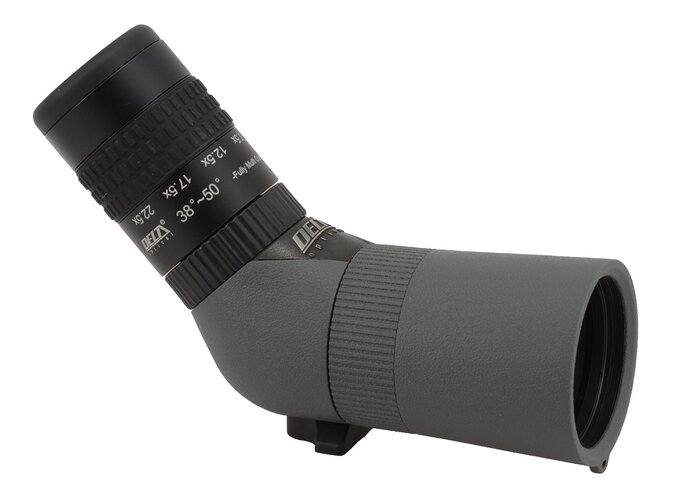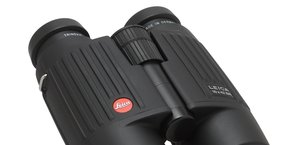Delta Optical Titanium 50ED – high magnification in your pocket
1. Delta Optical Titanium 50ED – high magnification in your pocket
Introduction
I suppose everyone has experienced such a situation: you are on a trip, you watch the nature and all of a sudden you wish you had a small, handy optical instrument with a high magnification ratio at your disposal. An instrument that is always there when you need it and allows you observations with magnifications of 12-20x, providing you can find a good support for your hands. A pipe dream? Not necessarily...
When the Delta Titanium 50ED spotting scope appeared on the market I was a tad surprised. I looked at its description and photographs, published on the producers' official site and I asked myself why the producers didn't employ an eyepiece from a bigger spotting scope model, that of 65 mm objective lens. After all that eyepiece has one serious advantage - its fields of view range from 50 to 70 degrees and these are values on both sides by about 10 degrees higher than in typical equipment of this class.
Please Support UsIf you enjoy our reviews and articles, and you want us to continue our work please, support our website by donating through PayPal. The funds are going to be used for paying our editorial team, renting servers, and equipping our testing studio; only that way we will be able to continue providing you interesting content for free. |
- - - - - - - - - - - - - - - - - - - - - - - - - - - - - - - - - - - - - - - - - - - - - - - -
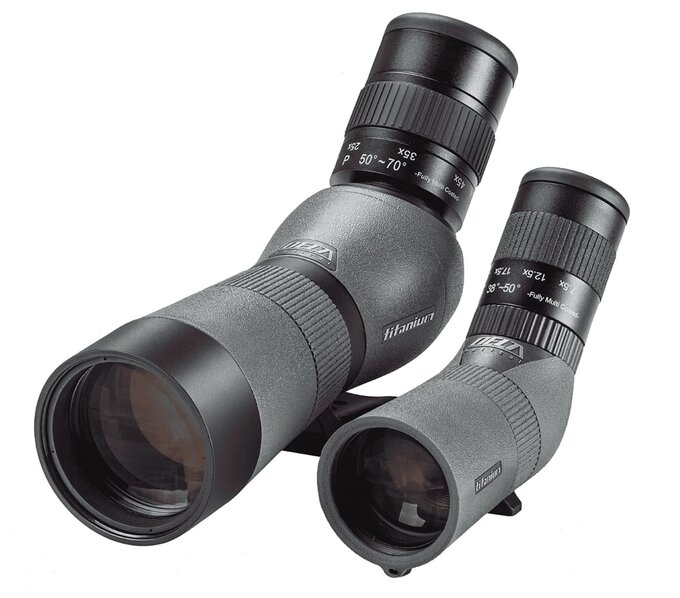 Delta Optical Titanium 65ED II and 50ED spotting scopes. |
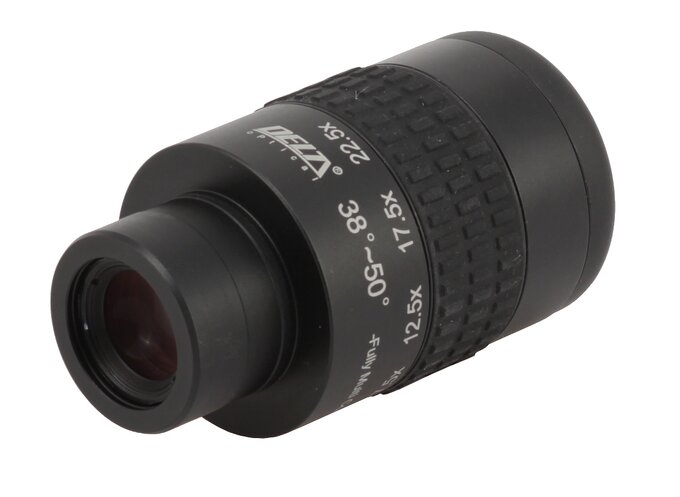 Zoom eyepiece added to the Delta Optical Titanium 50ED. |
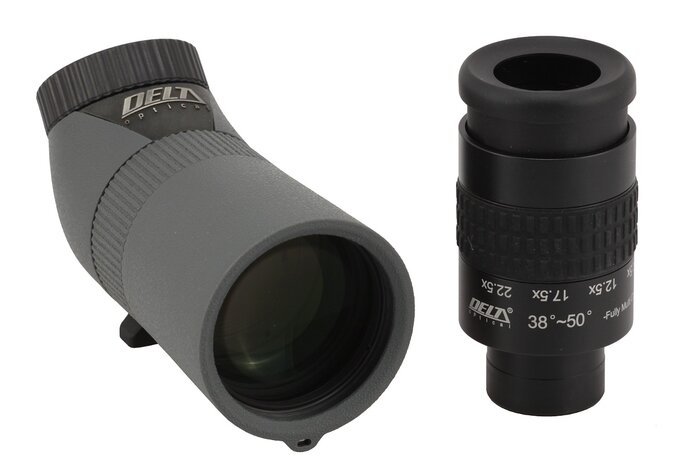 The Delta Optical Titanium 50ED with a zoom eyepiece. |
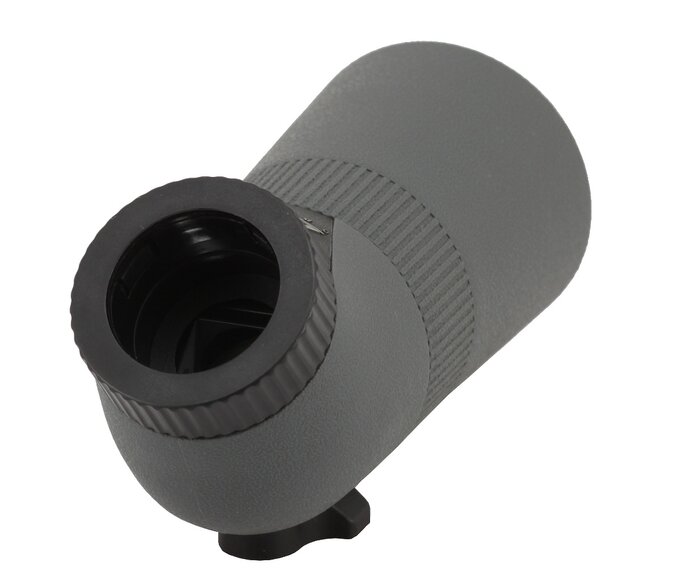 The Delta Optical Titanium 50ED – a view from the eyepiece mount. |
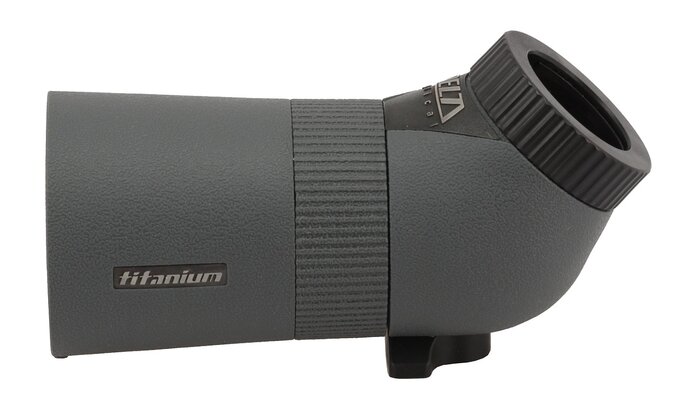 The Delta Optical Titanium 50ED without any eyepiece. |
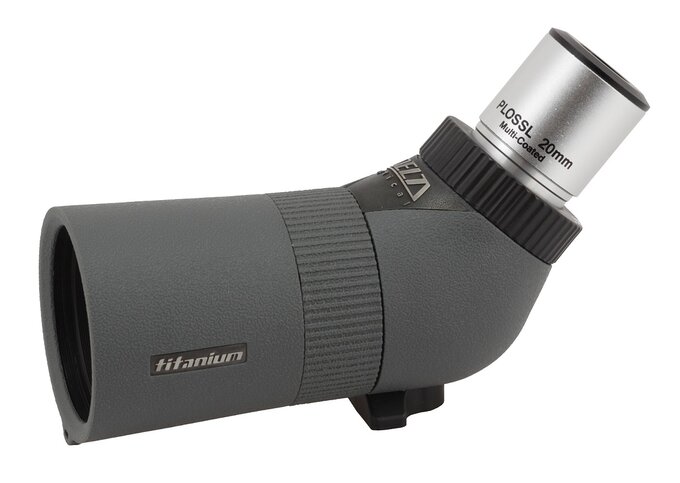 The Delta Optical Titanium 50ED with a cheap plossl 20 mm eyepiece. |
The spotting scope comes with a focal length of 170 mm so employing a cheap 20-25 mm plossl will allow you to enjoy magnification ranging from 6.8 to 8.5x without the necessity of limiting the field of view to 38 degrees.
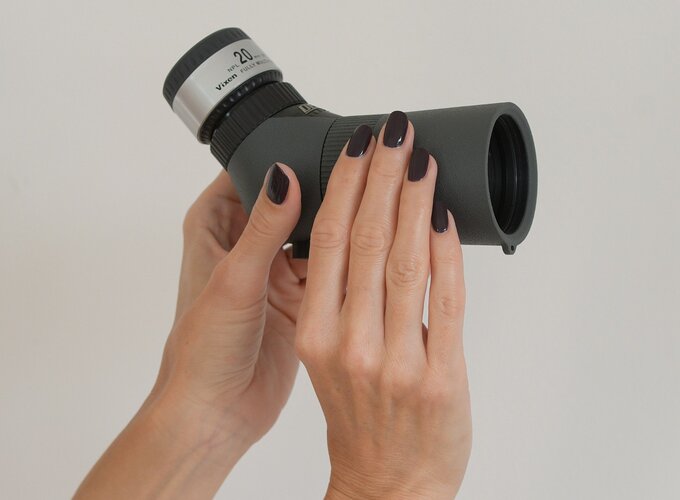 |
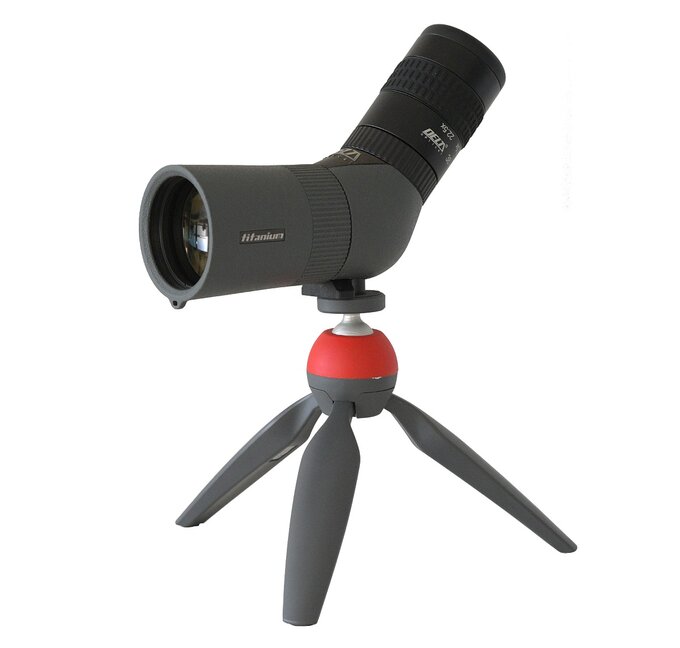 Delta Optical Titanium 50ED scope mounted on small tripod. |
As we got a whole series of budget eyepieces with the spotting scope for testing, we decided to check all these sets in practice and compare them to the zoom you get with the instrument in the box.
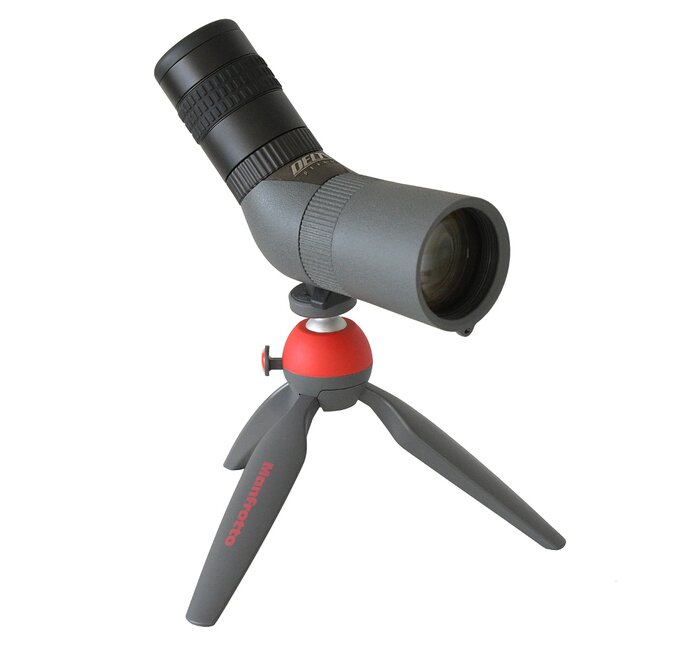 Delta Optical Titanium 50ED scope mounted on small tripod. |
The zoom eyepiece in action
In order to establish the right referece point let's start with analyzing the performance of the zoom ocular. At the smallest offered magnification (7.5x) images in the center are bright, sharp, and properly contrasted. It's a result of very good correction of astigmatism and chromatic aberration, which is practically invisible in the centre. Still, CA makes itself felt on the very edge of the field. Images show distinct barrel distortion but coma, sharpness, and brightness loss on the edge are corrected very well.Passing to 15x magnification doesn't change anything in the centre – you still can enjoy good resolution level. The performance concerning chromatic aberration is interesing – compared to the previous magnification its level increases slightly in the centre but it starts being corrected exceedingly well on edges. Distortion is lower and now you deal with slight pincushion deformations. Sharpness on the edge of the field can be described as good - only the last 5% are delicately 'misted'. Once again coma and brightness loss remain beyond reproach.
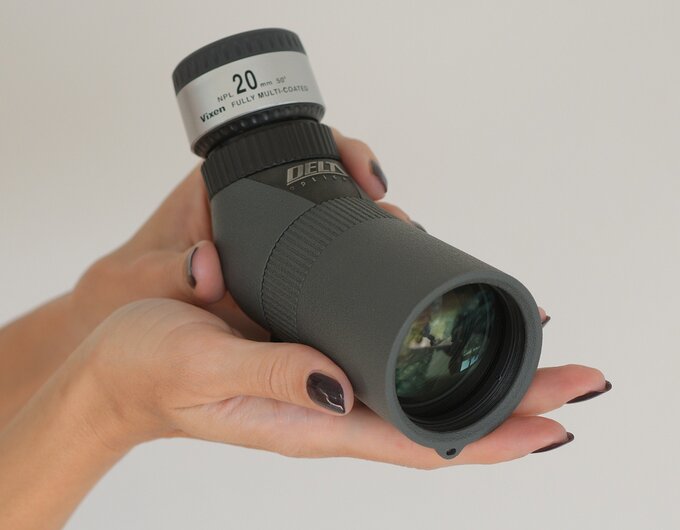 |
Across the whole range of magnifications the Delta doesn't have any problems with performance against bright light. When you look at bright lampposts at night you don't notice any serious light artifacts.
The cheapest plossl eyepiece – how will it fare?
Interestingly enough, compared to the zoom eyepiece, employing even the cheapest 20 mm plossl already brings you noticeable advantages,. Of course you get a wider apparent field of view and a higher magnification, amounting now to 8.5x; image remains very sharp, bright, and properly contrasted. On the edge of the field CA is practically zero – it means that aberration was brought about by the zoom eyepiece but low dispersion glass of the spotting scope performs as it should. You also notice less problems with distortion – it is just slight pincushion.Of course a cheap plossl has its own limitations. There is no convenient eyecup that can be regulated so the observations are not as comfortable as they should be – it's difficult to watch all the time along the axis so the diaphragm invades your field of view every other moment or you see 'exploding' blurry areas.
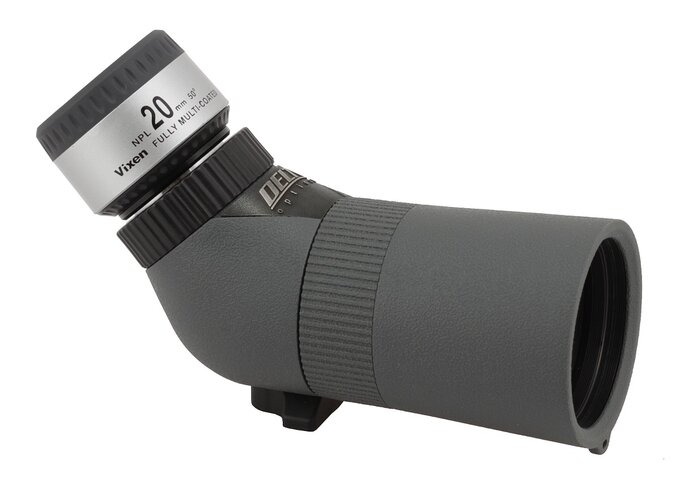 Delta Optical Titanium 50ED scope with Vixen NPL 20 mm eyepiece. |
A bit better plossl, the Vixen NPL
If you decide to spend a bit more and invest in a bit better plossl, for example The Vixen NPL 20 mm, most of the inconveniences, mentioned above, can be eliminated. You get a twist-up eyecup, comfortably supporting your eye socket. What's interesting, you won't get a lot when it comes to image quality. I was surprised by the fact that the Vixen showed a tad more chromatic aberration on edges (sharp diaphragm but with yellow rim), huge pincushion distortion and a tad more blurry areas on edges. Of course brightness of images and image quality in the field centre remained really good, not being different at all from images produced by the cheap plossl.
The Sky Watcher SWA-58 series, my personal favourite
I was really looking forward to the performance of the Sky Watcher SWA-58 20 mm. I admit that series is one of my personal favourites as an excellent combination of good quality, a sensible field of view, and a moderate price. One glance and you know the image in the centre is of a really high quality – bright and sharp. Chromatic aberration is almost invisible – negligible in the centre, a bit lower than medium on the edge. The diaphragm stands out nicely, without any colouring. The last 10% of the field of view still remains a tad blurry but deformation won't disturb you at all, as you get just 'pincushion' variation of very low level.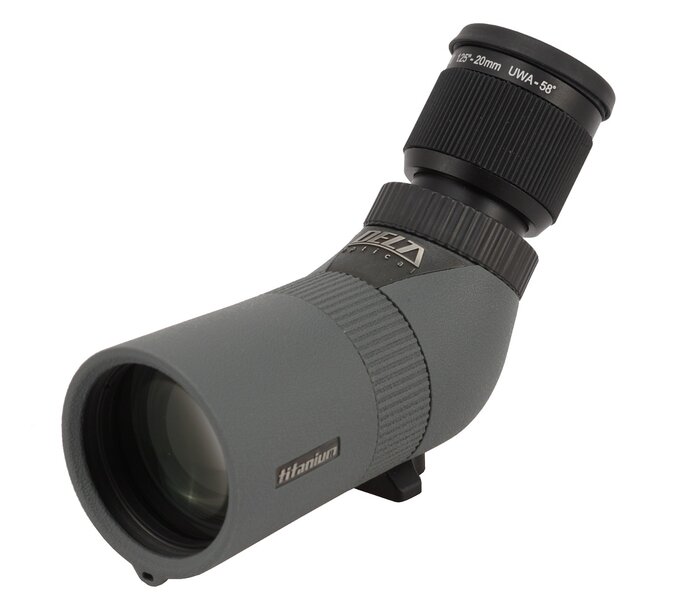 Delta Optical Titanium 50ED with Sky Watcher SWA-58 20 mm eyepiece. |
Older plossl devices manage fine too
Out of pure curiosity I joined the spotting scope with the old 17 mm Celestron plossl from the Nextar series. This construction can hadly be called new, I own it for more than a dozen years so. I suppose its older coatings make themselves felt because, even if the image in the centre is sharp, it is not as bright as it should be. The eyepiece joined with the objective lens corrects chromatic aberration exceedingly well and its level is very low both in the centre and on the edge of the field. The last 5-10% of the field is a bit blurry but the diaphragm itself is nicely exposed, without any colouring. Still you can notice distinct pincushion deformations.
The Vixen LVW shows its full potential
In order to check how the spotting scope deals with magnifications of more than a dozen times I attached to it my Vixen LVW 13 mm. Of course I did it as a kind of interesting experiment because recommending it for this device would be over the top, mainly because of its price and physical dimensions. Still I wanted to see how the spotting scope might perform with a high quality eyepiece with a wider field of view. I wasn't disappointed. Images in the centre are bright and sharp, the diaphragm stands out nicely with just a slight purple hue. Chromatic aberration in the field centre is also negligible and a tad lower than medium on the edge. Distortion doesn't disturb you almost at all, you can notice just slight pincushion. It turned out the Delta spotting scope with a good quality eyepiece is optically a very well done combination. If you have something like that at hand make the most of that opportunity.
Sky Watcher SWA-58 instruments with shorter focal lengths
Then I attached two Sky Watcher SWA-59 eyepieces with 7 and 6 mm focal length to the tested Titanium 50ED. After that the spotting scope provides you with, respectively, 24.3 and 28.3x magnifications. The cooperation with the former was quite nice – images in the centre were of good quality but not as excellent as with smaller magnifications. Chromatic aberration was very low in the centre and medium at most on the edge. The diaphragm proved to be quite sharp and without any colouring, images were also sharp almost to the very edges, and distortion amounted practically to zero.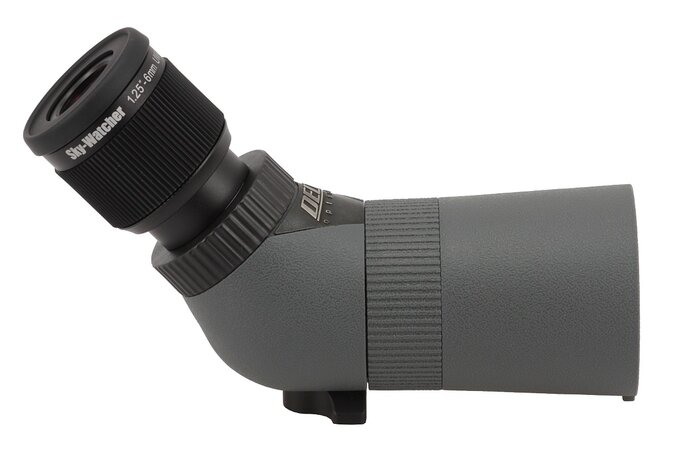 Delta Optical Titanium 50ED scope with Sky Watcher SWA-58 6 mm eyepiece. |
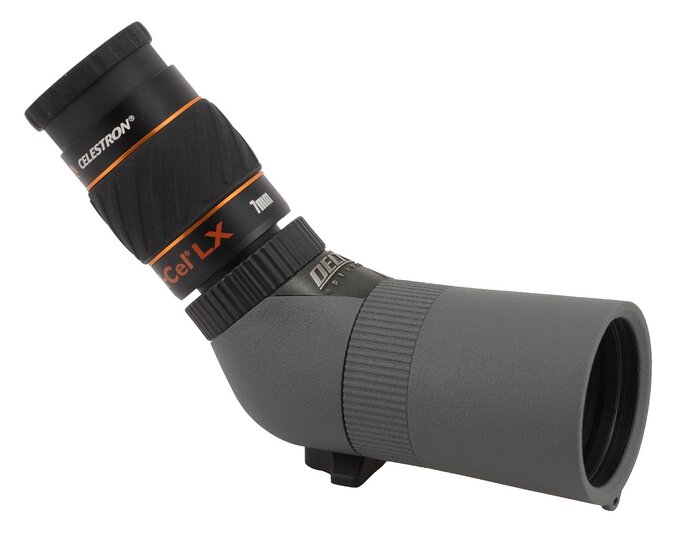 Delta Optical Titanium 50ED with Celestron X-Cel 7 mm eyepiece. |
The Celestron X-Cel can handle it as well
Entering the area of a bit wider apparent field of view and a bit more complex eyepieces I decided to attach the Celestron X-Cel 7 mm to the tested instrument. If you compare it to the SWA-58 with the same focal length you find out images in the centre is a tad sharper, the field of view – wider and better corrected on the edge, practically devoid of distortion. Chromatic aberration is a tad more pronounced for a change. Overall the X-Cel is able to cooperate with the DOT 50ED a bit better than the optically simpler SWA-58 but it is bigger, heavier, and more expensive. Should you still take it into your consideration? I suppose everybody has to answer this question on their own.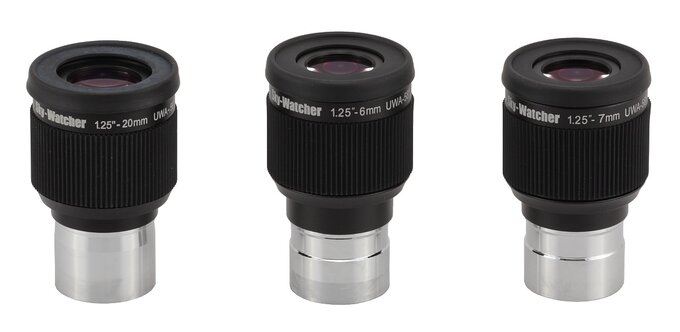 Super-plossl Sky Watcher SWA-58 eyepieces with focal lengths of 20, 6 and 7 mm. |
Time for some conclusions
What conclusions can be drawn from our tests? Firstly, you definitely should think about buying this spotting scope with a set of 2-3 additional eyepieces, even if you can afford just low-budget versions of ordinary, cheap plossl devices. If you want a bit wider field of view and a comfortable eye relief, consider buying the SWA-58 super-plossls. Personally I recommend the 20 mm model which allows you a magnification of 8.5x and the eyepiece with 10-15 mm focal length that ensures you a magnification of more than a dozen times.The third eyepiece, with the biggest magnification, is more of a moot point. Firstly I don't recommend any cheap plossl devices because, with a focal lenght of just several mm, you won't get a comfortable eye relief. As you see it's far more reasonable to spend a bit more on an eyepiece of SWA-58 or X-Cel type. Secondly, the magnification depends a bit on our personal preferences and demands concerning image quality. Personally I wouldn't employ anything shorter than 6-7 mm but, I suppose, some people would still accept a 5 mm model. Still I definitely advise against 3-4 mm eyepieces which provide 42.5-56.7x magnification. This spotting scope is simply not designed for such high magnifications and you would have to use a solid tripod anyway; such a piece of equipment makes you lose any assets connected to the mobility of a small spotting scope.
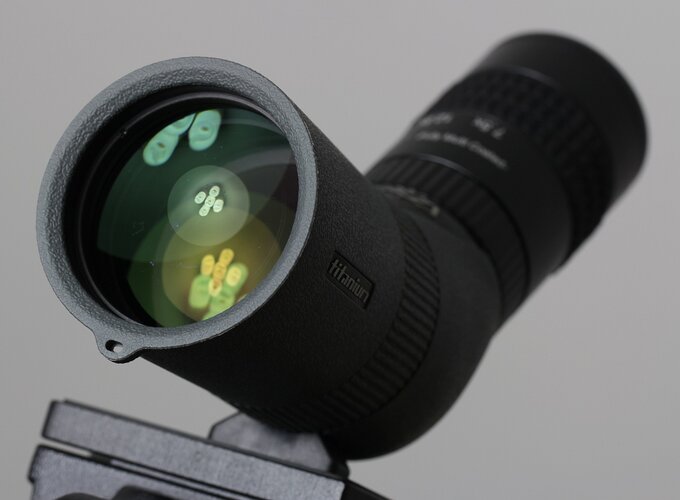 Antireflection coatings of Delta Optical Titanium 50ED scope. |
A few words about mechanics and build quality
As we've written a lot about optics, at the end we would like to add some information about mechanics, used materials, and build quality. The tested spotting scope presents itself really well. Its barrel is covered by good quality, textured rubber armour that sticks to your hands as it should. Looking at the objective lens you see multicoloured reflections, green, yellow, and purple. These reflections aren't intensive which means good quality multi coatings have been employed. The interior of the tube is dark, matt, with a lot of ribs and apertures. The bottom near the prisms is also decently darkened. The prisms themselves show green reflections. We didn't notice any dirt or specks of dust inside the construction.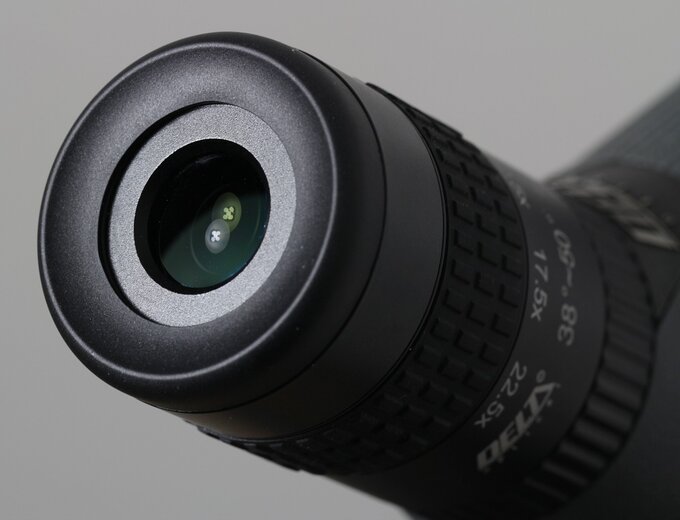 Antireflection coatings of Delta Optical Titanium 50ED as seen from the eyepiece side. |
 Exit pupils of Delta Optical Titanium 50ED spotting scope. |
Buyers get in the box: caps for the objective and the eyepiece along with a case. The spotting scope comes with a 5-year warranty period of the producer and its suggested retail price amounts to 1190 PLN.
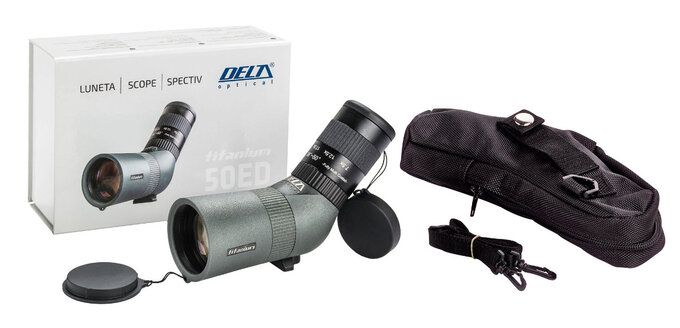 The Delta Optical Titanium 50ED with a zoom lens and other accessories you get in the box. |
Summary
The title of this article wasn't an exaggeration. The Delta Optical Titanium 50ED is a really handy spotting scope, providing you will add to it a small, fixed-focal 10-20 mm eyepiece. Such a piece of equipment can easily fit your average parka pocket, offering you a magnification ranging from several to more than a dozen times. If additionally you buy a good quality 6-7 mm eyepiece and a small tripod you will be able to profit from even higher magnifications and still such a set remains compact and very handy.To sum up: the Delta Optical Titanium 50ED is a small and lightweight spotting scope, perfect for every traveller, walker, nature watcher, sporting shooter who wants to admire the results on a shooting target removed by more than a dozen meters, or just an ordinary observer who would like to position such a spotting scope on their balcony or window sill. The possibility of joining this instrument with 1.25'' standard eyepieces makes it even more useful and, in my opinion, it's a serious selling point when compared to its direct rivals.
Article supported by Delta Optical company.




